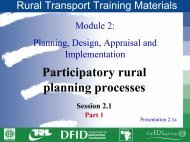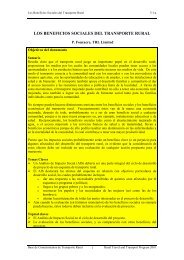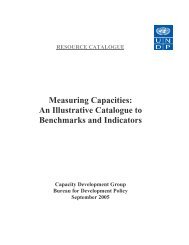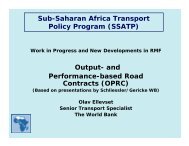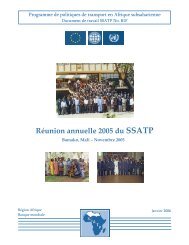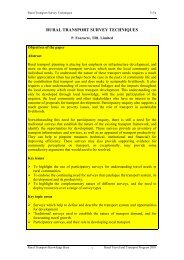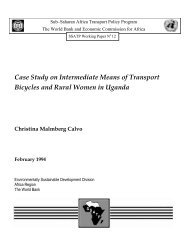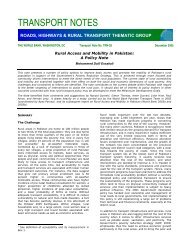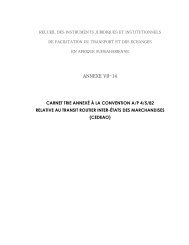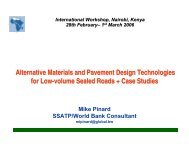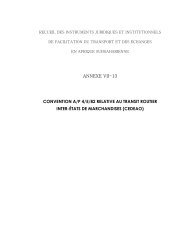Urban Transport - World Bank
Urban Transport - World Bank
Urban Transport - World Bank
You also want an ePaper? Increase the reach of your titles
YUMPU automatically turns print PDFs into web optimized ePapers that Google loves.
Africa <strong>Transport</strong> Policy Program (SSATP)<br />
Preparation of Third Development Plan (DP3)<br />
<strong>Urban</strong> <strong>Transport</strong> - Mobility and Accessibility Cluster<br />
Minutes of Stakeholders’ Meeting<br />
Addis Ababa – October 26, 2012<br />
1
Table of Contents<br />
Introduction .................................................................................................................................................. 3<br />
Session on Governance and Legal Framework ............................................................................................ 3<br />
Session on Capacity Development ............................................................................................................... 4<br />
Session on Financing .................................................................................................................................... 6<br />
Other Aspects ............................................................................................................................................... 8<br />
Next Steps ..................................................................................................................................................... 8<br />
Annex 1: Agenda of the Addis Meeting ....................................................................................................... 9<br />
Annex 2: List of Participants ...................................................................................................................... 10<br />
Annex 3: Survey on strategic priorities for the Third SSATP Development Plan (2014-2017) ................ 12<br />
2
Introduction<br />
Africa <strong>Transport</strong> Policy Program (SSATP)<br />
Preparation of Third Development Plan (DP3)<br />
<strong>Urban</strong> <strong>Transport</strong> - Mobility and Accessibility Cluster<br />
Minutes of Stakeholders’ Meeting<br />
Addis Ababa – October 26, 2012<br />
The meeting took place after the CODATU conference (October 22-25, 2012) on the theme of<br />
“The role of urban mobility in (re)shaping cities”. The agenda of the meeting is attached in<br />
Annex 1 and the list of participants in Annex 2. The participants represented central<br />
governments, local governments, transport institutions, the private sector and development<br />
partners.<br />
The objective of the meeting was to reach a consensus and a common understanding on urban<br />
transport policy issues related to mobility and accessibility in sub-Saharan Africa, and to provide<br />
a strategic vision for the proposed SSATP Third Development Program (DP3 2014-2017). The<br />
results of a survey of the participants on the strategic priorities for the DP3 in the urban mobility<br />
and accessibility areas are provided in Annex 3.<br />
The meeting was introduced by a short presentation on urban transport in sub-Saharan Africa:<br />
Emerging Trends, Challenges and Future.<br />
Session on Governance and Legal Framework<br />
The session focused on two main themes:<br />
- Institutional framework for urban transport: urban transport institutions, coordination and<br />
integration;<br />
- Gap between urban transport institutions and the political level.<br />
Before deciding on the legal framework for urban transport, the first step should be to develop a<br />
vision for urban transport. This vision should be translated in legal instruments which define<br />
clearly roles and responsibilities at the various levels of the institutional framework for urban<br />
transport: central government, local government, municipalities, urban transport authorities. This<br />
will improve sustainability of urban transport authorities which is uncertain, not due to the lack<br />
of efficiency of poor performance, but more due to the lack of understanding of the role and<br />
mandate of these authorities in the absence of legal instruments reflecting a shared vision.<br />
An agreement was reached that urban transport is a local responsibility of the municipalities.<br />
Starting from the presentation of the various model of urban transport institutional frameworks in<br />
Africa, the participants emphasized the need for coordination among the numerous institutions<br />
involved in urban transport. The institutional framework should recognize the leadership at local<br />
3
level and define the coordination arrangements with in particular the central or local<br />
governments but also other central/local institutions involved in urban transport.<br />
On the other side, some level of integration between urban transport management and other<br />
municipal functions is also necessary. Land-use management, stormwater drainage, road<br />
maintenance are important municipal functions with a significant amount of interaction with<br />
urban mobility. The vision for urban transport and the legal instruments should specify and detail<br />
the type of functions which should be integrated.<br />
The participants generally agreed on urban transport authority as a model for the lead institution<br />
for urban transport. However, the authority needs to reflect in the legal instruments for its<br />
creation, the vision, the need for coordination and the level of integration (Tanzania model of<br />
steering committee, CETUD model in Senegal with participation of central government, local<br />
government and private sector). The model of LAMATA in Nigeria was given as successful in<br />
working with local authorities to develop the BRT system, while Tanzania developed a vision for<br />
urban transport before LAMATA was created but was unable to develop the proposed BRT in<br />
the absence of an urban transport authority able to coordinate implementation of the vision.<br />
Participants pointed out the need to make a distinction between capital cities and secondary<br />
cities. Capital cities present the additional challenge of giving a greater political visibility to<br />
urban mobility. It may be easier to develop institutional frameworks for secondary cities which<br />
in turn could become model for capital cities.<br />
A critical condition of success and sustainability of the urban mobility framework is the capacity<br />
of urban transport institutions to communicate with politicians. The participants to the meeting<br />
recognized the communication gap with urban transport institutions unable to respond to the<br />
concerns from the politicians. While politicians are interested in satisfying the demand for<br />
mobility from urban dwellers or in the ways their actions impact on economic growth and<br />
poverty alleviation of urban households, urban transport institutions have not been able to<br />
communicate on the link between urban transport mobility programs and these concerns or on<br />
how the institutional framework is appropriate to address these concerns.<br />
Implementing these strategic orientations require adapting to the level of readiness of countries<br />
to promote urban mobility and adopt appropriate institutional frameworks. The participants<br />
identified three main levels of readiness:<br />
- Countries which have already made progress in implementing these orientations, such as<br />
South Africa, Senegal and Liberia;<br />
- Countries which are aware of urban mobility issues and interested in taking actions but<br />
are uncertain on the way forward;<br />
- Countries which are unwilling to take actions either because they are not informed or<br />
because they are not interested.<br />
The meeting recommended that SSATP identify strategies to facilitate development of urban<br />
transport policies adapted to each case of readiness and pilot these strategies in countries as<br />
examples from which other countries could learn to develop their own strategies. SSATP was<br />
encouraged to implement these pilots using a system involving peer countries building on the<br />
network of urban transport practitioners in Africa.<br />
4
Session on Capacity Development<br />
In general, capacity development (CD) was understood and discussed from a number of<br />
dimensions, particularly:<br />
• Technical competence in urban transport at the municipal level;<br />
• Leadership competence in urban transport at the level of decision-makers both at the<br />
political level and in the upper echelons of the civil service; and<br />
• Advocacy and awareness building at various levels of government, including local and<br />
national government, but also international institutions as well, such as the AU and<br />
UNECA. Such awareness-building would focus on the importance of sustainable urban<br />
development and transport as an urgent national priority across Africa.<br />
A recurring theme that kept emerging was the question of devolution of responsibilities to local<br />
levels. This is key to identify the objective for the achievement of which capacity needs to be<br />
built and who has been given the mandate to achieve this objective. In some cases participants<br />
indicated that governments were realizing for the first time that authority for urban transport<br />
should be vested in city authorities, and in others, such as Zambia, authority had previously been<br />
vested there, but following a period of centralization driven by political concerns and a poor<br />
policy framework, was being re-devolved to the local level.<br />
The theme of capacity development as a means of operationalizing devolution of urban transport<br />
authority to local levels emerged in two ways during the discussion. First, there was a clear need<br />
expressed by many participants that capacity needed to be built at local levels as part of the<br />
process of devolution of responsibility for urban transport from national or provincial<br />
governments to local governments. Second, several participants noted that the lack of capacity<br />
for effective urban transport management at local levels was inappropriately driving decisions<br />
about where to vest authority for urban transport planning. There was a strong consensus that<br />
authority for urban transport should be vested at municipal or metropolitan levels of government,<br />
and that capacity should therefore be created there. Authority should not be vested at the central<br />
level merely because it is claimed that capacity resides there.<br />
With respect to the theme of technical competence building among municipal or metropolitan<br />
transport agencies or authorities, five key functions were identified as critical, which could form<br />
the basis of SSATP CD activities in urban transport related to technical competence. These are:<br />
a) Capacity to plan for transport services;<br />
b) Capacity to program manage infrastructure development projects;<br />
c) Capacity to implement and oversee public service contracts (for rail, bus, and paratransit<br />
services);<br />
d) Capacity to regulate (for taxi and transitional bus services); and<br />
e) Capacity to manage processes of stakeholder engagement to assure the effective<br />
functioning and transition of the above.<br />
These needs could form the basis for a core set of SSATP capacity-development oriented<br />
activities.<br />
5
With respect to leadership competence in urban transport planning, several workshop<br />
participants highlighted the need to ensure that political leaders develop an understanding of the<br />
kinds of longer term issues associated with urban transport that transcend the short time frame of<br />
the political cycle. To be sure, political leaders will continue to make many decisions that reflect<br />
immediate political expediency, but efforts should be made to try to ensure an understanding of<br />
longer-term issues. One suggested option to pursue this would be to use the SSATP network to<br />
deliver CD in this area under the <strong>World</strong> <strong>Bank</strong>'s Leaders in <strong>Urban</strong> <strong>Transport</strong> Program.<br />
With respect to advocacy and awareness building, participants highlighted that such efforts<br />
would need to be addressed at many different levels of government, including local, national,<br />
and, indeed, international levels. Little capacity exists in these areas currently and the<br />
participants emphasized that capacity building is important to create a practical mass of<br />
practitioners which can carry out the advocacy work. At the local level, one participant<br />
highlighted six key areas for advocacy intervention:<br />
a) Understanding the role of public transport in shaping cities. This was suggested<br />
specifically in the context of addressing the powerful car lobby which often works at<br />
cross purposes of the objective of expanding public transport extent and services.<br />
b) Understanding key stakeholders better, particularly the taxi / paratransit sector.<br />
c) Doing better assessment of the impact of public transport interventions, particularly in<br />
terms of environmental and social impacts. Indeed, several participants highlighted the<br />
need to be able to better articulate for policy makers the link between public transport<br />
provision and poverty alleviation.<br />
d) Doing better alternatives analysis of transportation options when investments are<br />
contemplated, in order to have a clear picture of the lifecycle cost implications of<br />
different interventions.<br />
e) Provide assistance to technical staff in governments at different levels on how to address<br />
unsolicited proposals which can often capture the attention and imagination of political<br />
decision makers. Examples of unsolicited proposals can include a proposed real estate<br />
development around a highway that is not consistent with current land-use regulations, a<br />
proposal to use a particular fuel or vehicle propulsion technology not based on any<br />
established performance standard, or even an unexpected proposal to develop a particular<br />
mode of transport along a particular corridor.<br />
f) Understanding the linkage between urban transport and other issues related to urban<br />
growth and development, such as land-use planning. Several participants highlighted the<br />
need to understand why better coordination between transport and land-use was not being<br />
carried out in Sub-Saharan Africa.<br />
At national and continental levels, it was felt that there is little recognition of sustainable urban<br />
development and sustainable transport policy as a policy agenda item worthy of high-level<br />
consideration at par with other development agenda topics such as agriculture, energy<br />
development, natural resource use and protection, etc. Participants highlighted the potential role<br />
that SSATP and the Environmentally Sustainable <strong>Transport</strong> Forum for Africa (EST-Africa)<br />
could play in helping to highlight the importance of sustainable urban transport to high level<br />
policy makers.<br />
6
The key role for academia was also highlighted by several speakers. While governments are<br />
happy to highlight their successes, they are more reticent about sharing their failures, yet often<br />
more key knowledge and lessons can be gleaned from failures than from successes. In that<br />
respect, academia has a key role to play in both technical development and advocacy, because it<br />
is in a better position to highlight failures and the reasons some interventions did not work. It<br />
was suggested that EST-Africa could play a very important role in helping to bring together and<br />
disseminate academic knowledge on urban transport.<br />
Related to the role of academia, several participants honed in on the role of management of data<br />
and knowledge, highlighting the benefits to the continent of urban transport observatories and<br />
knowledge centers. Unlike classic academia, the role of such centers and observatories would not<br />
be to conduct research per se, but rather to act as a clearinghouse for knowledge, statistics, and<br />
database information, and to make such resources available and interpretable for the benefit of<br />
agencies and institutions in charge of implementing urban transport solutions. SSATP has<br />
considerable experience in helping establish observatories in other domains, and a program for<br />
establishing urban transport observatories might be a logical continuation of its work program in<br />
the urban arena.<br />
Session on Financing<br />
Discussions focused on:<br />
• Mechanisms to finance the gaps in the operating cost of public transport projects;<br />
• Mechanisms to finance the cost of the institutions/authorities to be set up for the<br />
coordinated management of urban transport; and<br />
• The role that SSATP could play in this regard.<br />
While some speakers felt that public transport, especially public bus services, could self-finance<br />
operating costs, others felt that a certain amount of subsidy was called for and was justified. It<br />
was suggested that public transport follows a broad 80-20 rule, where 80% of the costs can get<br />
covered through the fare box but the remaining 20% needs to be provided from other sources.<br />
All participants agreed, based on the world wide experience, that mass public transport can only<br />
exceptionally cover part of the infrastructure cost from its revenues. However policies should<br />
define clearly what can be financed by public funds (infrastructure, equipment, operating<br />
subsidy, capacity building). Participants emphasized the need to make the distinction between<br />
compensation and subsidy which reflect a difference in terms of policy approaches.<br />
It was generally agreed that if good quality services are required, especially to attract the users of<br />
personal motor vehicles, then a certain amount of subsidy is to be expected. However, if the<br />
services are inefficient then this subsidy may go up. Use of the private sector helps bring about<br />
greater efficiency and allows the level of subsidy to be competitively decided.<br />
It was mentioned that there were several sources that could be tapped for generating additional<br />
resources to pay this subsidy. High parking fees, congestion charging and fuel tax were a few of<br />
the possible sources. Besides, commercial exploitation of land held by the transport agency<br />
would be a good source of revenue. The example of the employment tax in France was also<br />
given.<br />
7
There was also a mention that corruption took a toll and funds were not used optimally due to<br />
high levels of corruption in some cities.<br />
With regard to financing of the lead transport agencies, it was mentioned that STIF, in Paris, is<br />
allowed to use some portion of employment tax for its administrative expenses. In London, the<br />
TfL collects a congestion charge and also parking fees. In addition there is financing provided by<br />
the national government. LAMATA too in Nigeria is allowed to retain a small fee on the road<br />
projects it is required to manage, to meet its administrative costs and the costs for some of the<br />
studies that it needs to carry out from time to time.<br />
The meeting agreed that there are several models available for adequate funding of the<br />
institutions that would be responsible for coordinating and managing the urban transport related<br />
activities. The model best suited to a particular context needs to be used and there is no single<br />
model that is universally applicable.<br />
Funding of actions to mitigate the impact of urban mobility on climate change is particularly<br />
important in the context of sustainable transport. One participant provided the recommendation<br />
to look at the additional cost to be green in urban transport to facilitate access to green funds.<br />
With regard to the role of SSATP, it was generally agreed that SSATP needs to help develop<br />
capacity about a fiscal framework for urban transport covering central and local governments<br />
and municipalities and make the relevant global information available to all countries. SSATP<br />
was requested to develop models of funding mechanisms for urban transport in particular<br />
identifying categories of costs that can be covered by public funds and conditions under which<br />
cities can access public funds for urban transport and provide support to countries to pilot these<br />
models. One specific model would explore the financing aspects of Public-Private Partnership<br />
for urban transport.<br />
In addition SSATP would have a very important role in advocacy and sensitizing the top political<br />
leadership to the global best practices in financing public transport as well as the lead institutions<br />
that need to be set up. This covers in particular considerations about fiscal transfers within the<br />
sector by adopting a system approach rather than a modal approach, and the financial<br />
consequences of applying various policies in terms of market conditions (full liberalization,<br />
competition for the market, competition within the market). This advocacy work would also<br />
include establishing benchmarks related to financing aspects of urban transport and monitoring<br />
performance of countries against these benchmarks.<br />
Other aspects<br />
A number of recommendations were provided by the participants, which complement the<br />
discussions in the three areas above:<br />
- The participants suggested that SSATP work on the role of planning as a critical activity<br />
for the success of improving urban mobility.<br />
- Regional Centers of knowledge would need to be set up to preserve the knowledge and<br />
make it available to underpin development and implementation of urban transport<br />
policies, institutional frameworks and operations in African countries.<br />
8
- <strong>Urban</strong> transport has a strong element of social aspects. SSATP was urged to champion<br />
inclusion of social and environmental issues in urban transport.<br />
- SSATP was requested to define benchmarks in the various areas of and linked to urban<br />
mobility, including in particular indicators on the impact of urban mobility on economic<br />
growth, poverty alleviation, cities efficiency, air pollution, road safety.<br />
- Pilots projects suggested during the discussions above should be developed in<br />
consultation with African urban transport practitioners to ensure that they are the most<br />
relevant and that they benefit the whole community of practitioners.<br />
- Following the presentation of the new institutional framework for the SSATP proposed<br />
for the DP3, SSATP was requested to prepare and disseminate terms of reference of its<br />
focal points in the countries.<br />
- Taking account of the limited resources of SSATP, it will be important during the<br />
definition of the DP3 to align the resources and the activities. For example, participants<br />
indicated that BRT systems are a good standard for Africa around which SSATP could<br />
focus its policy and institutional development activities.<br />
- The participants emphasized the need for strong ownership of the DP3 and for a<br />
consultation mechanism to provide for this ownership.<br />
Next steps<br />
The participants unanimously expressed their satisfaction to the SSATP for having organized this<br />
brain storming session. The participants found that the session should be used to set the<br />
foundation of a network of urban transport practitioners in Africa. The network would allow<br />
stakeholders to exchange experiences and then apply the knowledge which is developed<br />
internally in countries based on these experiences.<br />
An important component of the network would be dedicated to dissemination and advocacy. The<br />
meeting was an opportunity for the SSATP, UN-Habitat, UATP and CODATU to discuss<br />
synergies and joint efforts and programs in these two areas. The success of the joint CODATU<br />
conference and SSATP brain storming day which took place in Addis demonstrates the ‘bienfondé’<br />
of such approach. The next step is for SSATP to prepare a short summary of the minutes<br />
of the meeting in Addis in collaboration with the three other partners and distribute the summary<br />
to the Ministers of <strong>Transport</strong> and other stakeholders in the transport sector. UN-Habitat will<br />
prepare a similar note for presentation to the Ministers of <strong>Urban</strong> Development at the Africa<br />
Cities conference in March 2013.<br />
9
Annex 1: Agenda of the Addis meeting<br />
Time Event /Topic Actors<br />
09.00 – 09.10 Opening:<br />
- Brief overview of SSATP<br />
- Objective of the seminar & what we expect<br />
to achieve by the end of the day<br />
expectations<br />
09.10 – 09.30 Presentation: Background issues and options<br />
paper – current problems of urban transport<br />
in SSA, emerging issues and trends, key<br />
challenges and policy issues.<br />
09.30 – 10.30 Brainstorming session:<br />
Issue 1 – Governance and legal<br />
frameworks<br />
10.30 – 11.00 Coffee<br />
11.00 – 12.30 Brainstorming session:<br />
Issue 2 – Capacity development including<br />
policy and institutional development,<br />
strategic planning<br />
12.30 – 13.30 Lunch<br />
13.30 – 15.00 Brainstorming session:<br />
Issue 3 - Financing<br />
Jean-Noel Guillossou, SSATP<br />
Program Manager<br />
Presenter - Ramon Cruz<br />
Moderator – Nico McLachlan<br />
Moderator – Roger Gorham<br />
Moderator – O.P. Agarwal<br />
15.00 – 15.30 Coffee<br />
15.30 – 17.00 Wrap up on key issues and priorities for<br />
SSATP’s strategy for DP3<br />
Moderator - Jean-Noel<br />
Guillossou<br />
10
Annex 2: List of participants<br />
Name Title & Organization Country Email & phone number<br />
Julien ALLAIRE Technical Director, CODATU France Email: jallaire@codatu.org<br />
Jean-Claude ZIV CODATU France Email: jclziv@gmail.com<br />
Bernard Abeiku Ag. Chief Executive Officer, Centre for Ghana Email: ablkonsult@yahoo.co.uk<br />
ARTHUR<br />
Roger BEHRENS<br />
<strong>Urban</strong> <strong>Transport</strong>ation<br />
Associate Professor, Centre for<br />
<strong>Transport</strong> Studies, University of Cape<br />
Town<br />
South Africa<br />
Email: roger.behrens@uct.ac.za<br />
Xavier CREPIN Executive Manager, AdP "Villes en France Email: xavier@xavier-crepin.com<br />
Developpement"<br />
Ramon CRUZ SloCat Brazil Email: rcruz@alumni.princeton.edu<br />
Belew DAGNEW Asst. Professor, Ethiopian Civil Service Ethiopia Email: beldagnew@gmail.com<br />
University<br />
Debra Shish<br />
BHATTACHARJEE<br />
UN Habitat<br />
Email:<br />
debashish.bhattacharjee@unhabitat.org<br />
Xavier GODARD Consultant, independent France Email: x.godard@yahoo.fr<br />
Didier GREBERT Regional Manager for Ethiopia, Sudan,<br />
South Sudan, Somalia, Eritrea Agence<br />
française de développement (AFD)<br />
France Email: grebertd@afd.fr<br />
Andre CHAPACAIS Agence française de développement France Email: chapalaisa@afd.fr<br />
(AFD)<br />
Bernard Gyergyay Consultant, UN-Habitat Email: bernard.gyergyay@gmail.com<br />
Long Phung Xavier <strong>Urban</strong> <strong>Transport</strong> Specialist, AFD - France Email: Hoangx@afd.fr<br />
HOANG<br />
Agence Française de Développement<br />
Yao Godefroy<br />
KONAN<br />
Directeur des Etudes et de la<br />
Prospective, Agence des <strong>Transport</strong>s<br />
Côte d'Ivoire Email: godefroykonan@yahoo.fr<br />
Urbains (AGETU)<br />
Nico Mc LACHLAN Managing Director, ODA South Africa Email: nico@oda.co.za<br />
David MFINANGA Associate Professor in the Department Tanzania Email: mfinanga@udsm.ac.tz<br />
of <strong>Transport</strong>ation and Geotechnical<br />
Engineering, University of Dar es<br />
Salaam<br />
Dayo MOBEREOLA Managing Director, Lagos<br />
Nigeria Email: DMobereola@lamata-ng.com<br />
Metropolitan Area <strong>Transport</strong> Authority<br />
Sam Stewart<br />
Executive Director, Uganda Road Uganda Email: mutasamste@yahoo.com<br />
MUTABAZI<br />
Sector Support Initiative (URSSI)<br />
Louis Freddy Communauté urbaine de Yaoundé- Cameroon Email: freddyetoundi@yahoo.fr<br />
ETOUNDI TSALA Cameroun<br />
Alain RIES<br />
Ingénieur, Agence Française de France Email: riesa@afd.fr<br />
Développement<br />
Lisa SEFTEL Executive Director: <strong>Transport</strong>, City of South Africa Email: lisas@joburg.org.za<br />
Joburg<br />
Gbenga DAIRO Director, Public <strong>Transport</strong>, LAMATA Email: odairo@lamata-org.com<br />
Yorgos VOUKAS Senior Consultant, TRL, United UK Email: yvoukas@trl.co.uk<br />
Kingdom<br />
Heather ALLEN Senior Consultant, TRL, United UK Email: hallen@trl.co.uk<br />
Kingdom<br />
Feleke YIMER Ethiopia Email: feleke.yimer@yahoo.com<br />
Yechalal FENETA Addis Ababa University Email: yichilal.feneta@etabc.edu.ef<br />
11
Berhanu Wolde University of Lyon, France, ISC<br />
Email: berhanu.woldetensae@entpe.fr<br />
TENSAE<br />
Mark ZMIDGEEST University Twente Email: zmidgeest@itc.ne<br />
Dieter SCHWETA EURIST/SEI<br />
Nicolas ZIV<br />
Ecole Spéciale des Travaux Publiques<br />
Email: nicziv@hotmail.com<br />
(ESTP)<br />
Charles PATSIKA United Cities & Local Govts of Africa Email: ckpatsike@uciga.org<br />
David MUCHILWA Project Coordinator, Kenya National Kenya Email: david.muchilwa@kenha.co.ke<br />
Highways Authority<br />
P. C. KILIMO Roads Secretary, Ministry of Roads Kenya Email: pckilimo@gmail.com<br />
Levina OWUSU Acting Chief Director, Ministry of Ghana Email: levinaowusu@yahoo.co.uk<br />
Local Government and Rural<br />
Development<br />
Samson GYAMERA Head, Greater Accra Public <strong>Transport</strong> Ghana Email: samsongyamera@gmail.com<br />
Executive (interim), MLGRD<br />
Asteria MLAMBO <strong>Transport</strong>ation and Development<br />
Director, DART<br />
Tanzania Email: asteria_mlambo@yahoo.com<br />
Tel : +255 22 246 1093<br />
Boniface NYITI<br />
Mainza SIMOONGA<br />
Oumar NDIAYE<br />
<strong>Urban</strong> Development Division, Prime<br />
Minister's Office Regional<br />
Administration & Local Government<br />
Assistant Director of Engineering<br />
Service, Lusaka City Council<br />
Directeur Administratif et Financier du<br />
CETUD<br />
Tanzania<br />
Zambia<br />
Senegal<br />
Fax : +255 22 246 1098<br />
Email: nyitib@yahoo.co.uk<br />
Tel :.(255)(26) 2321607<br />
Fax (255)(26) 2322116<br />
Email: mainza1@yahoo.com<br />
Tel: 0977874111<br />
Email: omarsndiaye@yahoo.fr,<br />
aliounethiam@gmail.com,<br />
cetud@orange.sn<br />
Tel: +225 33 859 47 20<br />
Lutete Thomas<br />
MAKETA<br />
Prof. Economie de <strong>Transport</strong> RD Congo Email: mak_thom@yahoo.fr<br />
Tel: 0998165305 or 0811764755<br />
Christian Ukoko<br />
UKURANGO<br />
RDC Kinshasa City Train RD Congo Email: chrisukoko@yahoo.fr<br />
Tel: (+243)999922915, 816874998<br />
Cisse YSSOUFOU UATP Program Manager Côte d'Ivoire Email: uatp@uitp.org,<br />
yssoufouc@yahoo.fr<br />
Tel: +225 21 756 255<br />
Fax: +225 21 756 256<br />
Nomenjanahary<br />
Hanitriniony<br />
ANDRIAMISAINA<br />
Directeur du Déplacement Urbain de la<br />
Commune Urbaine d’Antananarivo,<br />
Ministère des <strong>Transport</strong>s et Commune<br />
Urbaine<br />
Madagascar<br />
Email: onytahina@yahoo.fr<br />
pst@moov.mg<br />
Jocelyn Yves<br />
RAZAFIMANJATO<br />
Secrétaire Général du Ministère des<br />
<strong>Transport</strong>s<br />
Madagascar Email: sg@mt.gov.mg<br />
pst@moov.mg<br />
Jhanard M. Privat<br />
ANDRIAMIARANTS<br />
OA<br />
Directeur des <strong>Transport</strong>s Routiers Madagascar Email: dtr@mt.gov.mg<br />
pst@moov.mg<br />
Tel : +(261) 34 04 965 27<br />
O.P. AGARWAL Sr <strong>Urban</strong> <strong>Transport</strong> Specialist, <strong>World</strong><br />
Email: oagarwal@worldbank.org<br />
<strong>Bank</strong><br />
Roger GORHAM <strong>Urban</strong> <strong>Transport</strong> Specialist, <strong>World</strong><br />
Email: rgorham@worldbank.org<br />
<strong>Bank</strong><br />
Jean-Noel<br />
Program Manager, SSATP<br />
Email: Jguillossou@worldbank.org<br />
GUILLOSSOU<br />
Camilla LEMA Senior <strong>Transport</strong> Specialist, SSATP Email: clema@worldbank.org<br />
Michalis P.<br />
ADAMANTIADIS<br />
<strong>Transport</strong> Policy Advisor<br />
Email: adamantm@gmail.com<br />
Per MATHIASEN Road Safety Consultant, SSATP Email: mathiasen@consia.com<br />
12
Annex 3: Survey on strategic priorities for the Third SSATP Development Plan (2014-2017)<br />
The participants to the workshop were invited to rate the priorities for their countries based on the<br />
following list established to achieve two main objectives:<br />
- Enhance accessibility and efficiency of urban transport systems and networks in cities in Africa;<br />
- Support the development of urban institutional frameworks to provide improved mobility and<br />
accessibility for urban dwellers.<br />
B1: Enhance accessibility and efficiency of urban transport systems and networks in cities in Africa<br />
B1.1: Analyze main policy issues for urban mobility and accessibility and propose solutions and<br />
guidelines<br />
B1.2: Promote linkages between urban transport and city development<br />
B1.3: Develop poverty aspects in urban transport strategies including Public <strong>Transport</strong> service planning<br />
for the urban poor<br />
B1.4: Foster public transport utilization in African cities and promote best practices and tools<br />
B1.5: Promote the development of urban transport strategies mitigating the negative impacts of<br />
transport on climate<br />
B1.6: Better integrate cities and their transport network with other networks (rural, ports, railways,<br />
national roads)<br />
B1.7: Improve planning of mass rapid transit system<br />
B1.8: Unleash the potential of pedestrian and non-motorized transport<br />
B1.9: Foster the application of information communication technologies (ICT) and intelligent transport<br />
systems (ITS) in urban transport<br />
B1.10: Foster south-south sharing of experience on urban mobility and strategies<br />
B2: Support the development of urban institutional frameworks to provide improved mobility and<br />
accessibility for urban dwellers<br />
B2.1: Continue bringing a national-level recognition of the importance of efficient and effective urban<br />
access and mobility using benchmarks for identifying trends and issues and comparing cities<br />
B2.2: Assess performance of institutional frameworks and capacity of sector institutions to address<br />
sector issues<br />
B2.3: Identify and promote principles for successful urban transport institutional frameworks for better<br />
planning, management and efficiency of urban transport systems<br />
B2.4: Develop policy guidelines and recommendations for better integration of urban transport<br />
planning and land-use planning oriented to cities and other sub-national governments<br />
B2.5: Develop policy guidelines and recommendations for fostering governance structures and<br />
financing mechanisms to facilitate better integration of urban transport planning and land-use planning,<br />
oriented to national governments<br />
B2.6: Pilot implementation of guidelines in selected cities using them as best examples<br />
13
B2.7: Analyze and introduce modern planning and modeling tools to guide transport and land use<br />
investments<br />
B2.8: Develop frameworks for sustainable funding of urban transport<br />
B2.9: Facilitate focused activities to unblock obstacles to transport implementation and/or coordination<br />
of transport and land-use<br />
The participants were also invited to indicate whether they consider that the SSATP DP3<br />
provides added value in this strategic area and whether their country/organization may seek<br />
support from SSATP.<br />
The following graph presents the percentage of answers from participants to the workshop<br />
according to the importance given to each strategic orientation. The higher part of each column<br />
(answers rated 4 and 5) represents a high importance, the lower part (answers rated 0 to 3)<br />
represents the lowest importance.<br />
Figure 1 : Importance of strategic orientations<br />
100%<br />
90%<br />
80%<br />
70%<br />
60%<br />
50%<br />
40%<br />
30%<br />
20%<br />
10%<br />
0%<br />
B1.1<br />
B1.2<br />
B1.3<br />
B1.4<br />
B1.5<br />
B1.6<br />
B1.7<br />
B1.8<br />
B1.9<br />
B1.10<br />
B2.1<br />
B2.2<br />
B2.3<br />
B2.4<br />
B2.5<br />
B2.6<br />
B2.7<br />
B2.8<br />
B2.9<br />
4-5<br />
- B1.9: Foster the application of information communication technologies (ICT) and intelligent<br />
transport systems (ITS) in urban transport.<br />
-<br />
Between 25 % and 50 % of the participants rated two priorities lower than 3:<br />
- B1.8: Unleash the potential of pedestrian and non-motorized transport<br />
- B1.10: Foster south-south sharing of experience on urban mobility and strategies<br />
2. Support the development of urban institutional frameworks to provide improved<br />
mobility and accessibility for urban dwellers<br />
Overall, strategic orientations associated to this objective receive a higher rating than for the first<br />
objective. However, five strategic orientations received an average rating below 3:<br />
- B2.4: Develop policy guidelines and recommendations for better integration of urban transport<br />
planning and land-use planning oriented to cities and other sub-national governments<br />
- B2.5: Develop policy guidelines and recommendations for fostering governance structures and<br />
financing mechanisms to facilitate better integration of urban transport planning and land-use<br />
planning, oriented to national governments<br />
- B2.6: Pilot implementation of guidelines in selected cities using them as best examples<br />
- B2.7: Analyse and introduce modern planning and modelling tools to guide transport and land use<br />
investments<br />
- B2.8: Facilitate focused activities to unblock obstacles to transport implementation and/or<br />
coordination of transport and land-use<br />
3. Added value of SSATP<br />
100%<br />
90%<br />
80%<br />
70%<br />
60%<br />
50%<br />
40%<br />
30%<br />
20%<br />
10%<br />
0%<br />
Figure 2 : Added Value of SSATP<br />
B1.1<br />
B1.2<br />
B1.3<br />
B1.4<br />
B1.5<br />
B1.6<br />
B1.7<br />
B1.8<br />
B1.9<br />
B1.10<br />
B2.1<br />
B2.2<br />
B2.3<br />
B2.4<br />
B2.5<br />
B2.6<br />
B2.7<br />
B2.8<br />
B2.9<br />
No<br />
Yes<br />
Overall participants consider that SSATP can bring added value in the proposed strategic area . The<br />
lowest rating is given for the following strategic orientations:<br />
15
- B1.9: Foster the application of information communication technologies (ICT) and intelligent transport<br />
systems (ITS) in urban transport<br />
- B1.8: Unleash the potential of pedestrian and non-motorized transport<br />
- B1.10: Foster south-south sharing of experience on urban mobility and strategies<br />
- B2.9: Facilitate focused activities to unblock obstacles to transport implementation and/or coordination<br />
of transport and land-use<br />
4. Support from SSATP<br />
Figure 3 : Interest in support from SSATP<br />
100%<br />
90%<br />
80%<br />
70%<br />
60%<br />
50%<br />
40%<br />
30%<br />
20%<br />
10%<br />
0%<br />
B1.1<br />
B1.2<br />
B1.3<br />
B1.4<br />
B1.5<br />
B1.6<br />
B1.7<br />
B1.8<br />
B1.9<br />
B1.10<br />
B2.1<br />
B2.2<br />
B2.3<br />
B2.4<br />
B2.5<br />
B2.6<br />
B2.7<br />
B2.8<br />
B2.9<br />
No<br />
Yes<br />
Strategic orientation B1.9 again receives the lower rating with about 50 percent of participants<br />
indicating that they don’t envisage seeking support from SSATP. Other strategic orientations<br />
with percentages of interest lower than 80 percent are:<br />
- B1.5: Promote the development of urban transport strategies mitigating the negative impacts of<br />
transport on climate<br />
- B1.8: Unleash the potential of pedestrian and non-motorized transport<br />
- B2.5: Develop policy guidelines and recommendations for fostering governance structures and<br />
financing mechanisms to facilitate better integration of urban transport planning and land-use planning,<br />
oriented to national governments<br />
- B2.9: Facilitate focused activities to unblock obstacles to transport implementation and/or coordination<br />
of transport and land-use<br />
16







